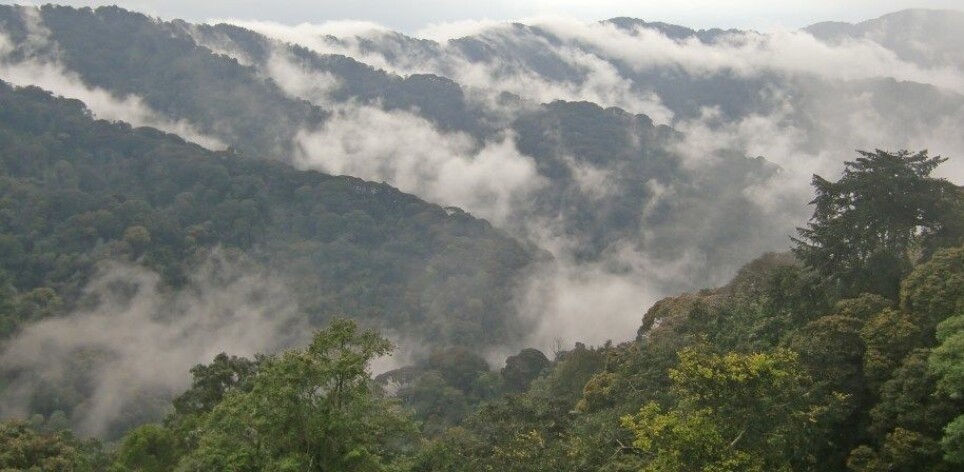THIS ARTICLE/PRESS RELEASE IS PAID FOR AND PRESENTED BY the Norwegian University of Life Sciences (NMBU) - read more

Africa’s mountain forests store more carbon than previously thought
New study in Nature shows that existing guidelines for African mountain forests greatly underestimate their role in global climate regulation.
Scientists studying tropical forests in Africa’s mountains were surprised to uncover how much carbon they store, and how fast some of these forests are being cleared.
The international study reported today in Nature, found that intact tropical mountain (or montane) forests in Africa store around 150 tonnes of carbon per hectare. This means that keeping a hectare of forest standing saves CO2 emissions equivalent to powering 100 homes with electricity for one year.

More carbon than the Amazon rainforest
The study found that African mountain forests store more carbon per unit area than the Amazon rainforest and are similar in structure to lowland forests in Africa. Existing guidelines for African mountain forests – which assume 89 tonnes of carbon per hectare – greatly underestimate their role in global climate regulation.
The international team also investigated how much tropical mountain forest had been lost from the African continent in the past 20 years. They found that 0.8 million hectares have been lost, mostly in the Democratic Republic of the Congo, Uganda and Ethiopia, emitting over 450 million tonnes of CO22 into the atmosphere. If current deforestation rates continue, a further 0.5 million hectares of these forests would be lost by 2030.
Large trees are abundant in mountain forests
“The results are surprising because the climate in mountains would be expected to lead to low carbon forests,” explains lead author Aida Cuni-Sanchez (NMBU and University of York). “The lower temperatures of mountains and the long periods they are covered by clouds should slow tree growth, while strong winds and steep unstable slopes might limit how big trees can get before they fall over and die. But unlike other continents, in Africa we found the same carbon store per unit area in lowland and mountain forests. Contrary to what we expected, large trees remain abundant in mountain forests, and these large trees (defined as having diameters over 70 cm) store a lot of carbon.”
Scientists measured 72,000 trees in 44 mountain sites in 12 African countries, from Guinea to Ethiopia and south to Mozambique. In each mountain site they established plots where they recorded the diameter, height and species of every tree. Researchers said that better knowledge about how much carbon mountain forests store is especially important for the ten African nations where the only tropical forests they have are those found on mountains.
“While we know what makes African forests special, we don’t yet know why they are different. It is possible that in Africa, the presence of large herbivores such as elephants plays an important role in mountain forest ecology, as these large animals disperse seeds and nutrients, and eat small trees creating space for others to grow larger, but this requires further investigation,” adds Cuni-Sanchez.
Co-author, Phil Platts (University of York and the IUCN’s Climate Change Specialist Group) says “About 5 per cent of Africa’s tropical mountain forests have been cleared since 2000, and in some countries the rate exceeds 20 per cent. Besides their importance for climate regulation, these forests are habitats for many rare and endangered species, and they provide very important water services to millions of people downstream.”
Avoiding deforestation is a bigger priority than forest restoration
Most African nations have committed large amounts of land to forest restoration under the Bonn Challenge. Although forest restoration is important to mitigate climate change, avoiding deforestation is a greater priority.
Martin Sullivan (co-author from Manchester Metropolitan University) adds: “Previous carbon estimates for tropical mountain forests in Africa were much lower than the values we report in our study. We hope that these new data will encourage carbon finance mechanisms towards avoided deforestation in tropical mountains. As outlined in the Paris Agreement, reducing tropical deforestation, in both lowland and mountain forests must be a priority.”
“Carbon finance mechanisms could help improve conservation interventions on the ground – even within protected areas, deforestation, forest degradation and defaunation remain a challenge,” explains co-author Gerard Imani (Université Oficielle de Bukavu in DR Congo).
Reference:
Aida Cuni-Sanchez et.al.: High aboveground carbon stock of African tropical montane forests. Nature, 2021. (Summary)
See more content from NMBU:
-
Shopping centres contribute to better health and quality of life
-
We're eating more cashew nuts – and the consequences are serious
-
Do young people with immigrant parents have better health?
-
Who’s picking your strawberries this summer?
-
Can coffee grounds and eggshells be turned into fuel?
-
Rising housing costs fuel inequality in Norway





































